This 2-ingredient sprouted sourdough bread from scratch is made without flour! Yes, you read that right! You’ll only need grains and water for the sprouted sourdough bread!
After reading about bread history – wild yeast bread, fermented grain drinks, flatbread and sourdough bread – I was interested in trying to make sourdough bread with just grains and water. This sprouted sourdough bread is basically a baked soured grain porridge just like a prehistoric human might have made it.
I couldn’t find a recipe for sprouted sourdough bread made with just grains and water – without yeast and flour – so I came up with this recipe. While the prehistoric human would have used two stones or a mortar to crush the grains I used a blender! 😉
Homemade Vs. Store-Bought Sourdough
Today, most store-bought sourdough bread isn’t real sourdough. Instead of fermented dough store-bought sourdough bread is made with sourdough flavoring! Additionally, store-bought bread is highly processed with preservatives and other additives. Store-bought bread made with refined flour has a high glycaemic index while sprouted and whole-grain breads have a low glycaemic index. Unsprouted whole-grain bread has a glycemic index of 51 whereas baguette has a glycemic value of 95 according to this source. Foods with a low glycaemic index value make people feel fuller for longer. So sprouted grain bread and traditional sourdough bread are the healthiest breads we can eat!
Sprouting Increases Nutrients and Reduces Antinutrients
Legumes, nuts, grains (and store-bought bread) contain phytic acid. Phytic acid is an antinutrient that prevents minerals like calcium and iron from being absorbed in the digestive tract. Soaking, sprouting and traditional sourdough making from scratch deactivates phytic acid. Sprouting also increases the protein, vitamin and mineral content, especially the vitamins A, B, C and E, and minerals like magnesium, calcium, potassium, copper and zinc.
Sprouted Sourdough Bread From Scratch – No Flour & No Yeast!
You’ll need:
- 450g rye or wheat grains
- water
- porcelain or glass bowls
- immersion blender or food processor
Day 1
Day 1 – Soak & Sprout The Grains
Ingredients:
- 50g rye or wheat grains
Directions:
Soak the grains in cold water for 8 – 12 hours. Then rinse and drain the grains. Sprout the grains for 8 – 12 hours until the sprouts are barely visible.
Day 2
Day 2 – Make The Sourdough Starter
Ingredients:
- soaked and sprouted rye or wheat grains from day 1
- 50ml water
Directions:
Blend sprouted grains with water until it looks like lumpy grain porridge and has a consistency of thick pancake batter. You can use a food processor or blender for this. I used an immersion blender. Cover the sourdough starter with cheesecloth to keep off the flies and let it ferment at room temperature for 24 hours.
Day 2 – Soak & Sprout More Grains
Ingredients:
- 50g rye or wheat grains
Directions:
Soak the grains in cold water for 8 – 12 hours. Then rinse and drain the grains. Sprout the grains for 8 – 12 hours until the sprouts are barely visible.
Day 3
Day 3 – Feed The Sourdough Starter
The sourdough starter starts smelling sour, looks slightly bubbly and the volume has increased.
Ingredients:
- soaked and sprouted rye or wheat grains from day 2
- 50ml water
Directions:
Blend sprouted grains with water. Then stir them into the sourdough starter and cover it again with cheesecloth. Leave it at room temperature for 24 hours.
Day 3 – Soak & Sprout More Grains
Ingredients:
- 100g + 250g rye or wheat grains
Directions:
Put 100g and 250g grain in separate bowls and soak the grains in cold water for 8 – 12 hours. Then rinse and drain the grains. Sprout the grains for 8 – 12 hours until the sprouts are barely visible.
Day 4
Day 4 – Feed The Sourdough
Ingredients:
- soaked and sprouted rye or wheat grains from day 3
- 100ml water
Directions:
Blend sprouted grains (the 100g from day 3) with water. Stir them into the sourdough starter. Cover and leave it at room temperature for 12 hours.
Rinse and drain the grains (the 250g from day 3). Sprout the grains for 8 – 12 hours.
Day 4 – Make The Bread Dough
Ingredients:
- sourdough starter
- soaked and sprouted rye or wheat grains from day 3
- 100ml water
- 1 tsp salt
- optional: 1 tsp each coriander seeds, caraway seeds and fennel seeds
Directions:
Blend sprouted grains with water and stir them into the sourdough starter. Add the spices. Put the dough into a greased pan. Cover and allow it to rise for 12 hours, until doubled in volume.
Day 5
Day 5 – Bake The Bread
Preheat the oven to 400°F (200°C). Bake the sourdough bread for 1 hour.
Sprouted sourdough bread is moister than homemade sourdough bread with flour. It also has a milder taste – it’s simply delicious!
More Bread Recipes Without Commercial Yeast
Please Pin It!
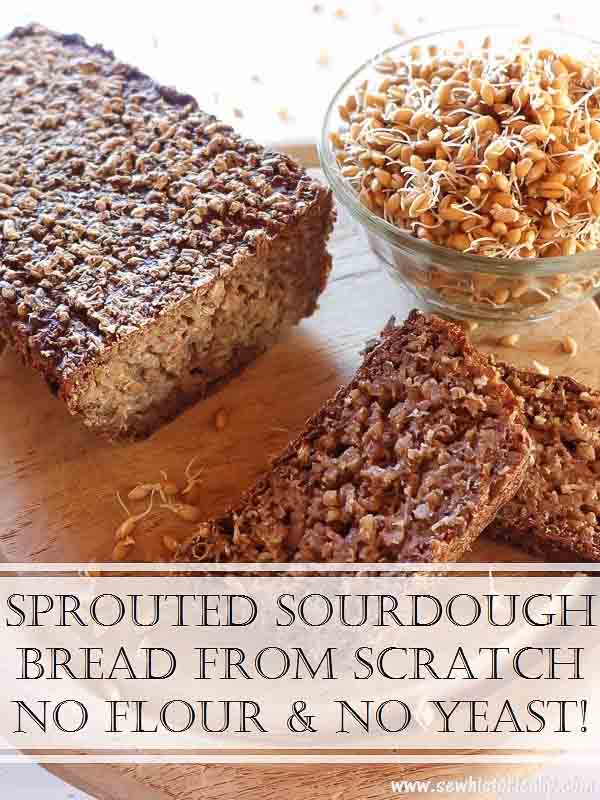
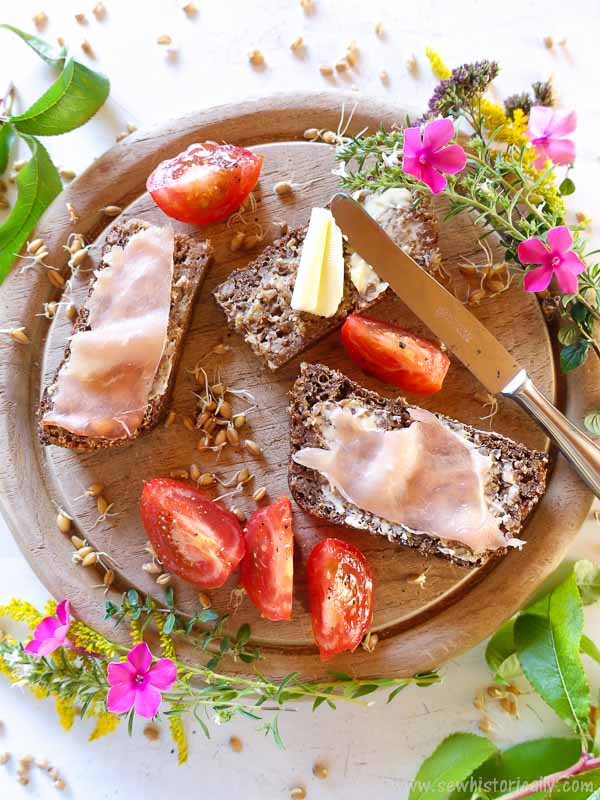
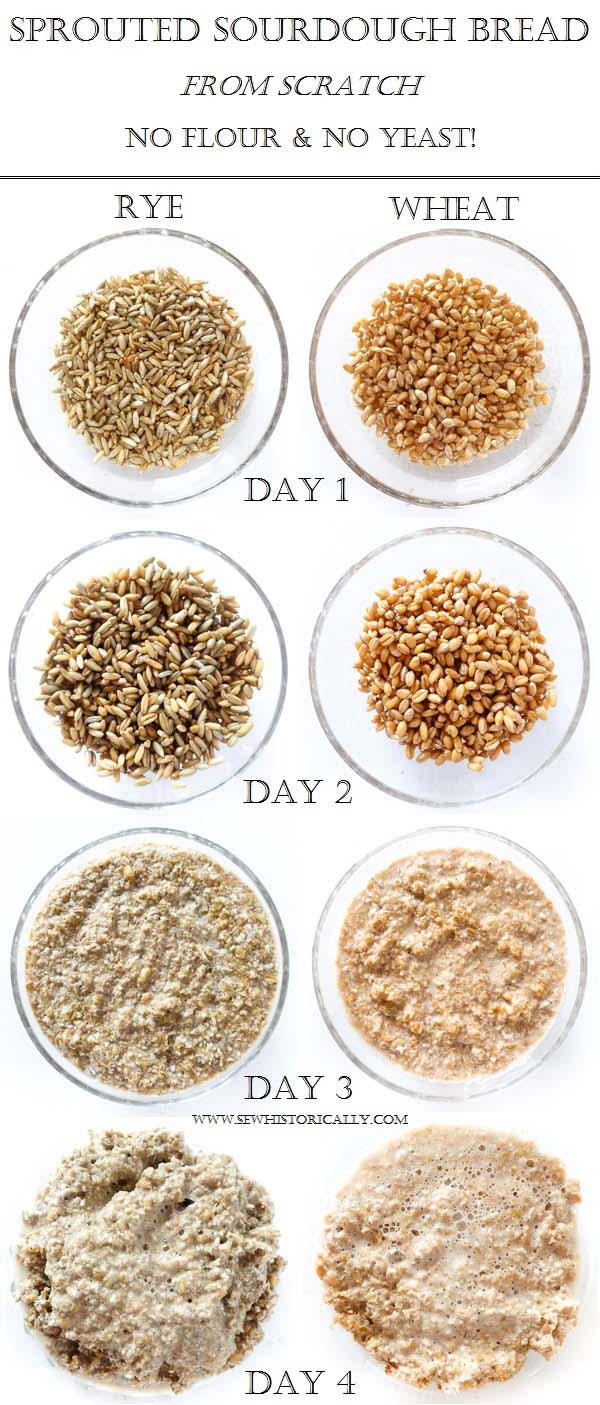
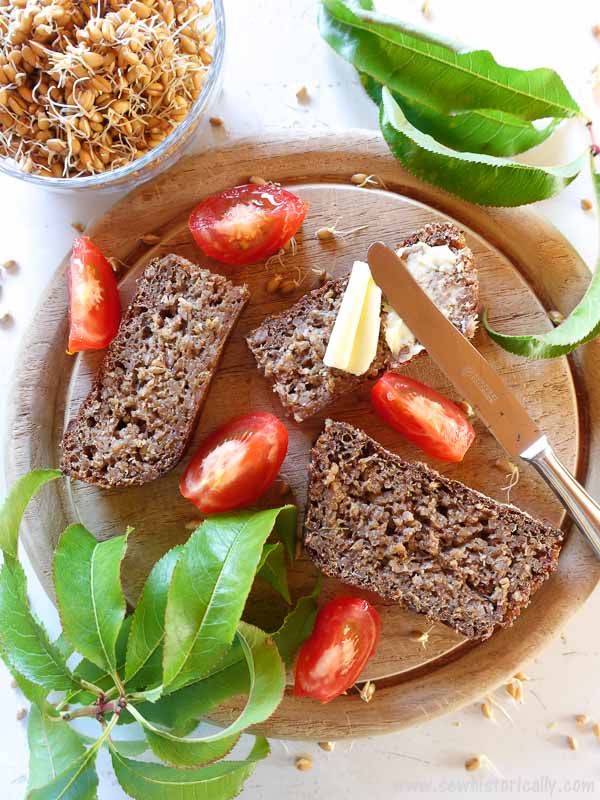

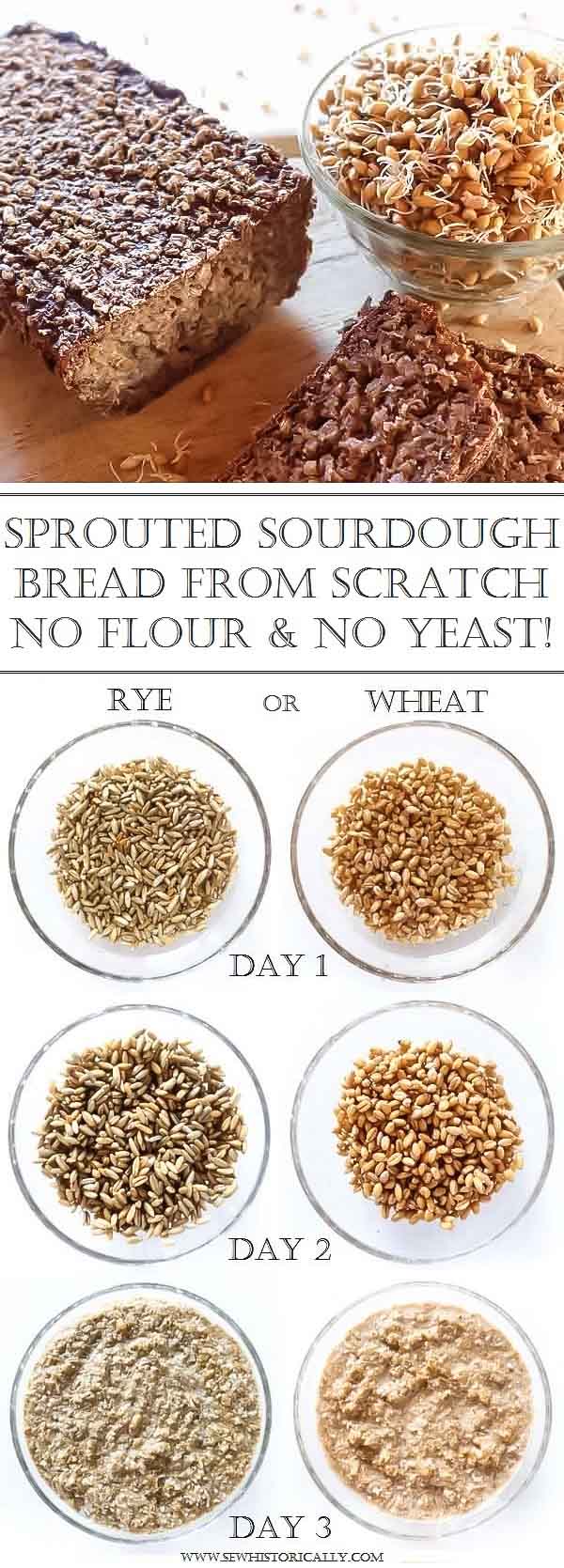
Good article! I make sprouted wheat bread by sprouting then dehydrating the sprouted wheat and then grinding it into flour. The resulting flour is so much lighter than regular whole wheat flour. I do use wheat, but I am excited to try this method of making sour dough!
Thanks, Helen!
Oooh, I’m gonna have to try this recipe sometime soon! I love sprouted grain bread!
Thanks, Catherine! Let me know how you like it! 🙂
Thank you so much for the recipe and tutorial! I have always wanted to make my own sprouted grain bread. saw your post at the bloggers pit stop. pinned:)
Thanks for pinning, Kathleen!
This looks really really good. Thank you for sharing.
Thanks, Lee!
Your recipe has certainly tweaked my interest as I love anything “sourdough” but without flour or yeast! I just might have to make this as I do need to wander out of my comfort zone every now and then. Thanks for a great idea and I know there are a lot of bread bakers and healthy ones at that who will love your recipe. Happy Fiesta Friday #248!
Thanks so much, Judith! 🙂
This looks quite interesting, and is worth a try. I will note that any sourdough bread I’ve had lately out does not taste like the sourdough I remember… this would definitely help. Thanks.
Thank you! Let me know how you like it! 🙂
Fascinating post – informative and very helpful info on making your own sprouted sourdough bread. Pinned and shared. #MMBC
Thanks for sharing, Carol!
This is a very interesting method of making sprouted bread. Do you know if using the sprouts like this eliminates the gluten content in the rye and wheat?
Kathleen
Blogger’s Pit Stop
Thanks, Kathleen! 🙂 I read that some gluten-sensitve people can eat sprouted and sourdough bread.
Thanks for sharing at the What’s for Dinner party! Have a fabulous weekend and hope to see you back on Sunday!
Thanks for stopping by, Helen!
I just baked my first loaf of sprouted sourdough wheat bread, and the results were beyond any expectation I had. Your recipe, and directions where spot on, and produced the best tasting bread I have ever had. It had a wonderfully chewy crust, and soft pillowy interior, and the Truly sourdough taste was beyond good. I am completely ruined when it comes to making bread now, only this process will do. Although your directions take time it was not time consuming. Thank you for take the time to provide such thorough directions. I’m soaking rye berries for my next loaf which will be a sprouted sourdough rye! I can’t wait! – Kathryn
Thank you so much for your lovely comment, Kathryn! 😀 I’m glad you like it!
Can you do a mixture of the two or does it have to be rye or wheat?
You can mix rye and wheat. 🙂
I wonder, if this is also ok for low carb (I’m diabetic)?
Sorry, I don’t know if it’s ok for low carb.
Yes, if you use whole grains it is, and this recipe is mostly intact whole grains which is even better, very good for diabetics and very low glycemic index, and very filling too. Won’t spike your insulin and will keep you full
Have you made crackers or rolls using this recipe? Have you tried freezing the bread? Have you made additional sourdough starter and kept it going longer, and if so, how long? Can sourdough starter be kept in the fridge and then pulled out and used later? I am trying to figure out all the ways I can use this recipe. 🙂
I haven’t made crackers or rolls yet; but freezing the bread works. And I haven’t kept it going longer but I think it should work and you can feed it just like ordinary sourdough. 🙂
Can you keep some of the starter to use in making other sourdough recipes?
Yes, I think it should work. 🙂
I have been looking for a recipe that works with sprouted wheat without the need for dehydrating it and grinding to flour (which does work great). I will try this by mixing the ground sprouted berries with regular whole wheat flour levain.. hopefully should work fine.
I’m glad you find it helpful! 🙂
Thank you so much. I have tried for many years to make bread without flour. Google suggested this web page for me and it has been a life changer.
Thank you! 🙂 I’m glad you like it!
I love the look of recipe and got very excited when I found it! I followed it exactly, except used einkorn grains instead of wheat. I have just baked the loaf and unfortunately it has gone terribly wrong. The crust has cooked perfectly but inside the mixture is still like porridge. I did wonder at the proofing stage if something was wrong because the consistency was nothing like dough and it did not increase in size at all. I would describe the consistency as a pancake batter and that’s how it has remained inside the loaf. Is there anything you could advise as to where I may have gone wrong? Many thanks.
Sprouted sourdough bread is moister than most homemade breads. It’s usually even moister than traditional sourdough bread with flour. And yes, unlike yeast bread, sprouted sourdough bread almost doesn’t increase in size during proofing. But you could try two things: Using a different type of grain for the bread, such as wheat, spelt or rye. Or letting the grains sprout for a shorter time (the sprouts should be barely visible): Letting the grains sprout for too long, destroys the gluten resulting in a flatter, porridge-like bread.
Ahh that might be they key! I let teh grains sprou for quite a while because I wasn’t seeing sprouts! Back to the drawing board. Thanks so much for your help.
I’m late to this thread, but —
Einkorn needs a lot less water than wheat or rye. So your dough was probably far too wet. The internet has lots of information on substituting einkorn in place of wheat – I THINK it needs about 1/3 less water, but I have not used einkorn yet so I’d recommend looking it up.
I do know from a very little bit of baking 100% rye breads and intact grain essene breads that really high hydration loaves may do better with a long, low bake so the interior cooks. I think here because of the excess water and the high temperature, the interior was not able to cook before the outside was done.
I finally got an instant read thermometer because getting the internal temperature to the right one has been a challenge for me to figure out when modifying recipes with different grains or grinds (I’ve seen 202-210 recommended for rye and other non-enriched breads, so that’s what I’ll shoot for with this – I’m on the final proof and I have high hopes!)
That sounds and looks amazing! Thanks for sharing this..
I’m going to try this and surely going to love it! Never tried baking with 100% sprouted grains
Do you think I could mix the type of grains, like spelt or oat or buckwheat or…?
Thank you so much! 😀 I often use spelt to make this bread. However, oat and buckwheat don’t have gluten to make sourdough bread from scratch. And I don’t know if it works if you mix spelt and oat (or buckwheat). I’d suggest that you use only spelt for your first try. And if you like the bread, you can start mixing the type of grains. If you try it, please let me know if it works! 🙂
Hi Lisa,
Would this recipe work with Kamut or Spelt?
Hi, I often use spelt to make this sprouted sourdough bread and it works well! 🙂 And it should work with kamut too.
This recipe is awesome, Lina! I have been wanting to make a sprouted grain bread w/o flour. Thank you so much for sharing your recipe! I followed it exactly with spelt. Tonight was my baking night – worked!! Now, I feel that I can fiddle with the content exploring some different grains and herbs. I wanted to add that in my Pyrex glass loaf pan, the dough rose about 1″ during the 12 hr. rise today. I could see lots of bubbles through the glass.
I also want to thank Mark who commented above. I will try a little lower temp. and longer bake to see if that makes a difference in loaf middle moistness. I did measure the internal loaf temperature at 60min. using 400F, and it was 204 degrees F.
Thanks so much, again, Lina!! Thumbs up and big smile to you! I would love to see more of your sprouted sourdough experiments.
Thank you so much! 😀 Glad you like it!